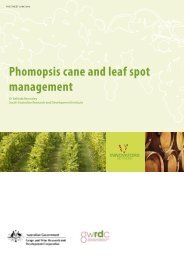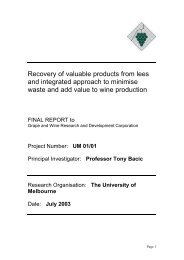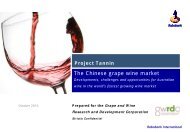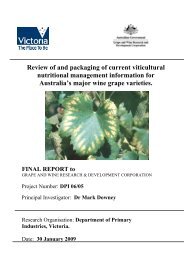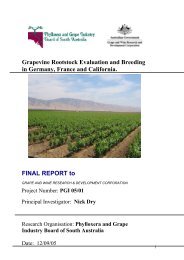Identification of the major drivers of 'phenolic' taste in ... - GWRDC
Identification of the major drivers of 'phenolic' taste in ... - GWRDC
Identification of the major drivers of 'phenolic' taste in ... - GWRDC
You also want an ePaper? Increase the reach of your titles
YUMPU automatically turns print PDFs into web optimized ePapers that Google loves.
AWRI: <strong>Identification</strong> Of The Major Drivers Of ‘Phenolic’ Taste In White W<strong>in</strong>es<br />
A.3 Development <strong>of</strong> a Separation and <strong>Identification</strong><br />
Strategy for Phenolic Compounds <strong>in</strong> White W<strong>in</strong>e<br />
by HPLC-DAD and HPLC-QTOF<br />
A.3.1 Introduction<br />
In order to identify and quantify <strong>the</strong> diverse ‘phenolic’ compounds found <strong>in</strong> white w<strong>in</strong>e, an HPLC<br />
technique suitable for migration to mass spectrometry was developed. With <strong>the</strong> express <strong>in</strong>tention <strong>of</strong><br />
not discrim<strong>in</strong>at<strong>in</strong>g aga<strong>in</strong>st possible species present that might elicit <strong>taste</strong> sensations characterized by<br />
<strong>the</strong> broad term ‘phenolic’, a SPE sample clean-up step was not considered appropriate. These<br />
decisions meant <strong>the</strong> chosen method had to be highly selective and discrim<strong>in</strong>atory. Sample preparation<br />
was thus based only on removal <strong>of</strong> alcohol by rotary evaporation and centrifugation replaced filtration<br />
to avoid adsorption onto filtration fibres.<br />
Method development followed a path <strong>of</strong> column selection – based on separat<strong>in</strong>g <strong>the</strong> maximum<br />
number <strong>of</strong> separate peaks – and <strong>the</strong>n mobile phase optimization.<br />
A.3.2 Material and Methods<br />
Chemicals<br />
All chromatographic solvents were HPLC grade and chemicals were analytical grade unless o<strong>the</strong>rwise<br />
stated. Water was obta<strong>in</strong>ed from a Milli-Q Academic (Millipore, France) purification system us<strong>in</strong>g a<br />
“Quantum” cartridge. methanol, acetonitrile (LiChrosolv, Merck, Germany), formic acid (98% v/v<br />
Emsure, Merck, Germany) and trifluoroacetic acid (100% v/v Thermo, IL) were purchased from<br />
Rowe Scientific (Lonsdale, SA, Australia). Polyphenolic standards were purchased from Sigma-<br />
Aldrich or Extrasynthèse (France).<br />
W<strong>in</strong>e Samples<br />
Experimental w<strong>in</strong>e was made at <strong>the</strong> Hick<strong>in</strong>botham-Roseworthy W<strong>in</strong>e Science Laboratory us<strong>in</strong>g<br />
established protocols. For <strong>the</strong> purposes <strong>of</strong> method development, a 2009 Riesl<strong>in</strong>g and a 2009<br />
Chardonnay w<strong>in</strong>e, made from <strong>the</strong> hard press<strong>in</strong>gs juice fractions, was used throughout.<br />
Preparation <strong>of</strong> W<strong>in</strong>e Samples<br />
White w<strong>in</strong>e samples were prepared by first remov<strong>in</strong>g alcohol by rotary evaporation (Heildorf,<br />
Germany) with a water bath temperature




